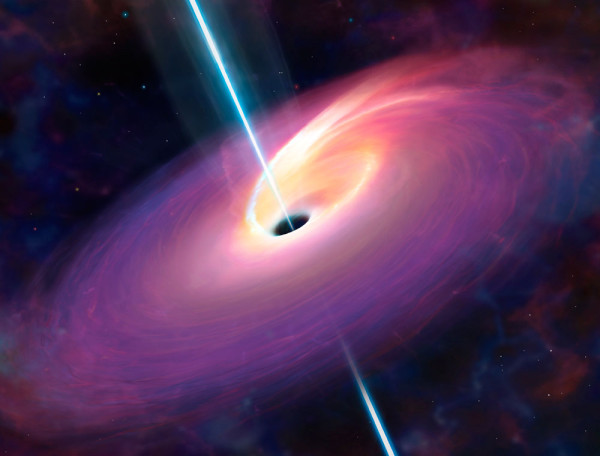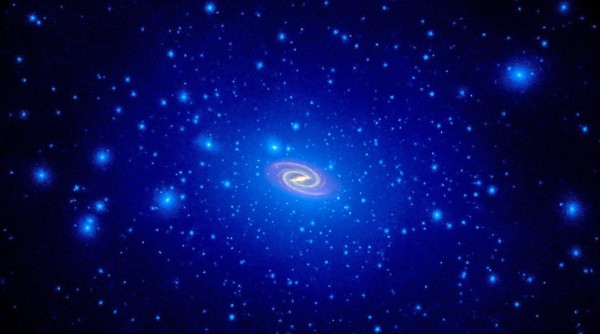“A single day is enough to make us a little larger or, another time, a little smaller.” -Paul Klee
As the time passes for us all, and we age, so too does everything else in the Universe. For an object like a black hole, it has the potential to form, grow or shrink as we move forward.
The question, of course, that we might ask is how, and by how much? Is normal (baryonic) matter the only culprit, or can dark matter make a difference for this as well? And if so, under what circumstances, and can it teach us anything about dark matter in the process?
Come learn about the relationship between dark matter and black holes in this week's Ask Ethan!
- Log in to post comments



Could a super scientist use a black hole as a dark matter detector?
If a super-advanced species built a protective sphere around an existing black hole (say at 1 AU distance) and kept all incoming matter away, would the gain in mass of the Black Hole be detectable over the course of a year?
Or would it be impossible to sufficiently shield it from cosmic rays and the like, so the flux of normal matter would swamp the dark matter flux?
Thank you for another excellent column. If black holes come from massive stars that don't produce enough radiation to prevent collapse, and those massive stars in turn come from condensation of variations in the overall uniform primordial distribution of matter, then why aren't there black holes formed entirely of dark matter? Why weren't there similar variations in the distribution of dark matter, which in turn collapsed (more rapidly, as not having nuclear fusion to generate delaying radiation pressure)?
thanks again!
@Davis #2: You ask a good question, and one which has been asked in others of Ethan's comment threads. My understanding (as a particle physicist, _not_ an astrophysicist) is that it's precisely dark matter's lack of interactions that prevent it from collapsing that way.
Normal gas and dust has "friction" -- local interactions which radiate away energy in the form of light or heat or pressure waves or whatever. Thus, an initial big ball of gas/dust will, over time, compress under gravity; the higher temperature will cause more heat/light to be emitted and slowing the particles down, locally reducing the pressure enough that compression can continue, until the density renders the stuff opaque, and you get a balance between gravity and pressure.
Dark matter, we believe, doesn't have those radiative interactions, just elastic (billiard-ball like) collisions. So you get a big ball of the stuff, and as it compresses under gravity, the particles (DM "gas") zip around faster and faster. Eventually, if you collapse too much (and this is at the scale of small galaxies!) the particles' average speed can exceed the escape velocity for the big ball. Now you have DM "evaporating" from the ball, both reducing its mass and tending to increase its size.
So with dark matter, you end up with haloes that are big and massive enough to draw in surrounding baryonic gas and dust. Those haloes, then, seed the earliest stars and galaxies.
So under the assumption that DM particles are just orbiting around(through) the matter density concentrations of galaxies/clusters, what is a typical DM particle velocity?
We know there are more than one kind of DM particles (we know about neutrinos, but they can only account for a tiny fraction of the total). If DM particles had substantial (by cosmic standards) cross-sections for interaction with baryons/photons, or other DM particles, how well is the strength of this constarined? If DM annihilates DM, but the rest mass is low enough, maybe the resultant photons are IR -or microwave or some wavelength to long for us to distinguish it from the background radiation)?
I could imagine DM particles might interact with the material in neutron stars, but their cross sections aren't much larger than BHs.
@Omega Centauri #4: We (SuperCDMS) model the DM distribution in the solar neighborhood as having a random (virialized) component of 220 km/s, corresponding to galactic orbital velocity at the Sun's position (that's the speed needed for the halo to remain a coherent structure on cosmic time scales). We then add in the solar orbital speed of 220 km/s, and an annual modulation of +/- 30 km/s (Earth's orbit around the Sun).
So, relative to Earth, the dark matter could have speeds ranging from 30 to 500 km/s.
I'm always frustrated to hear stuff like this (In Ethan's comments about black holes): "In order to escape from the gravitational field of our planet, we’d have to achieve a tremendous speed in order to do so: around 11,200 m/s (25,000 mph)." Wrong. Skylarks ascend vertically, against this gravitational pull, at around 30 mph. True, they don't escape Earth's gravitational field, but that's not because they're too slow. They run out of atmosphere, and their upward thrust is lost. But if our atmosphere continued into outer space, and these small birds had sufficient strength, they could escape our gravity field. The requirement for escape is not velocity, it is sustained power
#6 No, those escape velocities are correct, for ballistic objects. An object under constant thrust can escape at virtually any velocity.
By the way, Ethan; you got the speed of light wrong, near the beginning of the article. The last 3 digits should be “458.”
Dark matter as well as Dark Energy are true enigmas.Here is a preprint that explains these mystries as different manifestations of Quantum Gravity. https://www.academia.edu/8604226/The_Schwarzschild_Solution_to_the_Nexu…
The capture rate of baryonic matter depends to a fair extent on the fact that it can lose energy on approach to the event horizon. For instance, in a high-radiation density environment [1] it's going to be pretty seriously ionized, and losing energy by both electromagnetic interactions as well as collisions, resulting in decaying orbits around the BH.
As a result, the "vector of no return" for baryonic matter is much larger than the event horizon. Not so for dark matter; if its original hyperbolic course doesn't take it into the event horizon it will just continue on the same course and escape [2].
Actually, technically it would never enter the BH anyway, since it can't lose momentum relative to the BH it would (I'm not sure what) and continue anyway [3]. Or something. Maybe Ethan can explain what happens to the momentum of the DM on a direct collision course.
[1] Do you like my understatement?
[2] Actually, it is possible for a particle to gain or lose energy and momentum entirely by elastic gravitational exchanges, at least when it's part of a multi-body system. Ask Voyager.
[3] Of course, it would never actually get there so the question is pretty far from any practical solution.
Why is there an assumption that dark matter is WIMPs? Don't scientists still consider the possibility that all dark matter is primordial black holes to begin with? I've been following this question from afar over the years, and I've seen some pretty prestigious scientists say that dark matter could be entirely black holes.
Whats with these Axions??
http://www2.le.ac.uk/offices/press/press-releases/2014/october/inexplic…
http://arxiv.org/abs/1403.2436
http://rt.com/news/197116-dark-matter-detected-sun/
http://motls.blogspot.com/2014/10/an-overlooked-paper-discovering-axion…
-------------------------------------
I guess I'd be more than just a little bit confused. The stars are supposed to be producing the very thing holding it all somewhat 'together' instead of switching mass for energy??
@Tim #12: Unfortunately, in order to really understand "what's with these axions," you have to delve pretty deeply into the detailed math of quantum field theory. Your best bet is probably to start with the Wikipedia article (http://en.wikipedia.org/wiki/Axion) and go from there.